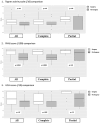Surgical Treatment of Proximal Hamstring Avulsion Injuries Compared With Nonsurgical Treatment: A Matched Comparative Study With a Mean Follow-up of >4 Years From the Proximal Hamstring Avulsion Surgery Cohort Study
- PMID: 39165177
- PMCID: PMC11402259
- DOI: 10.1177/03635465241270139
Surgical Treatment of Proximal Hamstring Avulsion Injuries Compared With Nonsurgical Treatment: A Matched Comparative Study With a Mean Follow-up of >4 Years From the Proximal Hamstring Avulsion Surgery Cohort Study
Abstract
Background: Surgical outcomes for proximal hamstring avulsion injury (PHAI) are well documented, yet comparative analyses with nonsurgical approaches remain scarce.
Purpose: To compare the functional outcomes between surgical and nonsurgical interventions for PHAI.
Study design: Cohort study; Level of evidence, 3.
Methods: This comparative study, conducted at a sports surgery center between January 2012 and July 2021, focused on patients with primary PHAI. The study was a retrospective analysis of prospectively collected data. Group selection involved utilizing propensity score matching to compare an arm of patients who were surgically treated (indications included patients with complete injury, patients with partial injury with >2 cm of retraction, and patients for whom 6 months of nonsurgical treatment failed) with another arm of patients who refused surgery. The primary outcome was evaluated using the Parisian Hamstring Avulsion Score (PHAS). The secondary outcomes included the Tegner Activity Scale (TAS) score; University of California, Los Angeles (UCLA) score; rate and quality of return to sport (RTS); and patient satisfaction.
Results: The study included 32 patients (mean age, 55.8 years [SD, 8.4 years]) in the nonsurgical treatment arm and 95 patients in the surgical treatment arm (mean age, 53.4 years [SD, 7.7 years]) (P > .05). The interval from injury to treatment was 5.7 months (SD, 9.6 months) for the surgical group and 12.7 months (SD, 25.9 months) for the nonsurgical group (P > .05). At the final follow-up (nonsurgical group: mean, 56.5 months [SD, 28.2 months]; surgical group: mean, 50.7 months [SD, 33.1 months]), the PHAS was significantly higher in the surgical group (mean, 86.3 [SD, 13.7]) compared with the nonsurgical group (mean, 69.8 [SD, 15.1]) (P < .0001). Higher activity scores were also observed in the surgical group for the TAS and UCLA scores (P = .0224 and P = .0026, respectively). A higher percentage of the surgical group (68.4%) returned to sports compared with the nonsurgical group (46.9%) (P = .0354), with a greater proportion in the surgical group returning at the same or higher level (67.7% vs 26.7%) (P = .0069). Additionally, a higher satisfaction level was reported by patients in the surgical group (89.5%) in contrast to the nonsurgical group (25%) (P < .0001). Three patients in the surgical group experienced complications (2 reruptures and 1 hyperesthesia at the pudendal nerve territories). Odds ratios (ORs) indicated that patients in the surgical group were significantly more likely to achieve or exceed median scores for the PHAS (OR, 6.79; P < .001), TAS score (OR, 2.29; P = .045), and UCLA score (OR, 3.63; P = .003), as well as to RTS at any level (OR, 2.46; P = .031) or at the preinjury level or higher (OR, 6.04; P < .001).
Conclusion: This study demonstrated that surgical treatment of PHAI significantly enhances long-term functional scores, including the PHAS, TAS score, UCLA score, satisfaction, and RTS, at a mean follow-up of >4 years compared with nonsurgical treatment.
Registration: NCT02906865 (ClinicalTrials.gov identifier).
Keywords: PHAI repair; hip; nonsurgical treatment; proximal hamstring avulsion injury; sports.
Conflict of interest statement
One or more of the authors has declared the following potential conflict of interest or source of funding: N.L. is a consultant for WebSurvey Society, Paris, France. A.H. is a consultant for Arthrex and DePuy. AOSSM checks author disclosures against the Open Payments Database (OPD). AOSSM has not conducted an independent investigation on the OPD and disclaims any liability or responsibility relating thereto.
Figures
References
-
- Amstutz HC, Thomas BJ, Jinnah R, Kim W, Grogan T, Yale C. Treatment of primary osteoarthritis of the hip: a comparison of total joint and surface replacement arthroplasty. J Bone Joint Surg Am. 1984;66(2):228-241. - PubMed
-
- Bodendorfer BM, Curley AJ, Kotler JA, et al.. Outcomes after operative and nonoperative treatment of proximal hamstring avulsions: a systematic review and meta-analysis. Am J Sports Med. 2018;46(11):2798-2808. - PubMed
-
- Hofmann KJ, Paggi A, Connors D, Miller SL. Complete avulsion of the proximal hamstring insertion: functional outcomes after nonsurgical treatment. J Bone Joint Surg Am. 2014;96(12):1022-1025. - PubMed
Publication types
MeSH terms
Associated data
LinkOut - more resources
Full Text Sources
Medical



